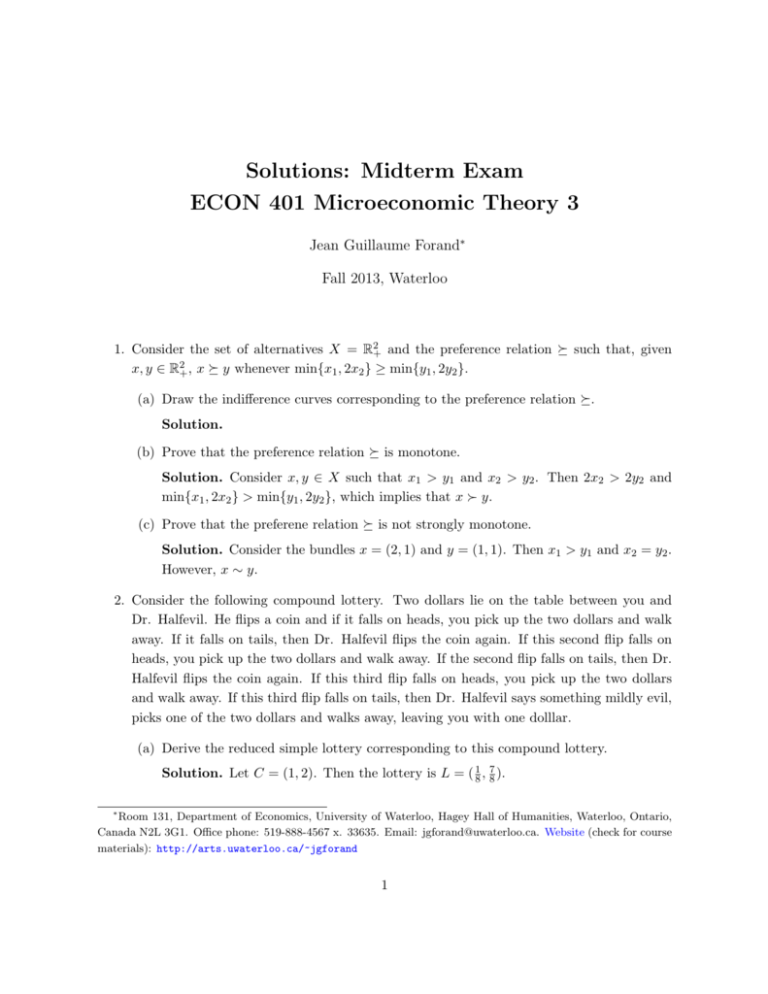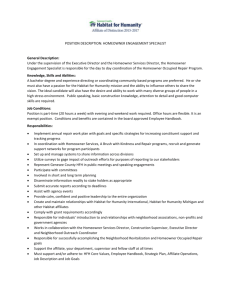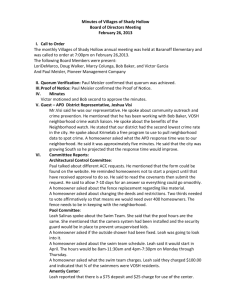Solutions: Midterm Exam ECON 401 Microeconomic Theory 3
advertisement

Solutions: Midterm Exam
ECON 401 Microeconomic Theory 3
Jean Guillaume Forand∗
Fall 2013, Waterloo
1. Consider the set of alternatives X = R2+ and the preference relation such that, given
x, y ∈ R2+ , x y whenever min{x1 , 2x2 } ≥ min{y1 , 2y2 }.
(a) Draw the indifference curves corresponding to the preference relation .
Solution.
(b) Prove that the preference relation is monotone.
Solution. Consider x, y ∈ X such that x1 > y1 and x2 > y2 . Then 2x2 > 2y2 and
min{x1 , 2x2 } > min{y1 , 2y2 }, which implies that x y.
(c) Prove that the preferene relation is not strongly monotone.
Solution. Consider the bundles x = (2, 1) and y = (1, 1). Then x1 > y1 and x2 = y2 .
However, x ∼ y.
2. Consider the following compound lottery. Two dollars lie on the table between you and
Dr. Halfevil. He flips a coin and if it falls on heads, you pick up the two dollars and walk
away. If it falls on tails, then Dr. Halfevil flips the coin again. If this second flip falls on
heads, you pick up the two dollars and walk away. If the second flip falls on tails, then Dr.
Halfevil flips the coin again. If this third flip falls on heads, you pick up the two dollars
and walk away. If this third flip falls on tails, then Dr. Halfevil says something mildly evil,
picks one of the two dollars and walks away, leaving you with one dolllar.
(a) Derive the reduced simple lottery corresponding to this compound lottery.
Solution. Let C = (1, 2). Then the lottery is L = ( 81 , 78 ).
∗
Room 131, Department of Economics, University of Waterloo, Hagey Hall of Humanities, Waterloo, Ontario,
Canada N2L 3G1. Office phone: 519-888-4567 x. 33635. Email: jgforand@uwaterloo.ca. Website (check for course
materials): http://arts.uwaterloo.ca/~jgforand
1
(b) From here on suppose that your Bernoulli utility function is u(x) = ln x. What is your
expected utility from this lottery?
Solution. Your expected utility is
1
8
7
ln 1 + 78 ln 2 = ln 2 8 .
(c) What is your certainty equivalent for this lottery?
7
Solution. Your certainty equivalent is 2 8 .
.
3. Let the final outcomes be C = (c1 , c2 , c3 ) and suppose that a decision-maker has preferences
over lotteries over C that are represented by a utility function U . Consider simple lotteries
L1 = (0, 1, 0), L2 = (0, 0, 1), L3 = ( 21 , 12 , 0) and L4 = ( 16 , 23 , 16 ). Suppose also that U (L1 ) = 2,
U (L2 ) = 2, U (L3 ) = 3 and U (L4 ) = 73 . Can the utility function U have the expected utility
property? If so, provide a candidate Bernoulli function u.
Solution. Consider a Bernoulli utility function u associated to U . Since U (L1 ) = u(c2 ), we
have u(c2 ) = 2. Similarly, we have u(c3 ) = 2. SInce U (L3 ) = 3, it must be that u(c1 ) = 4.
We need to verify that these values for u are consistent with U (L4 ) = 37 . We have that
2
1
7
1
6 (4) + 3 (2) + 6 (2) = 3 , as desired.
4. A homeowner has a house with market value v > 0. This house is subject to the risk of a
fire, which occurs with probability q and imposes damage F ∈ (0, v). The homeowner is
risk-neutral, i.e., its Bernoulli utility function is u(x) = x.
(a) Suppose that an insurance company offers a full coverage policy, that is, it offers a
policy that reimburses the homeowner for the full damages F if a fire occurs. What
is the actuarially fair premium for this policy?
Solution. The actuarially fair premium is the expected payout of the insurance company, which under full insurance is the expected damage qF .
(b) Show that the homeowner is indifferent between purchasing and not purchasing the
insurance policy from (a).
Solution. If the homeowner purchases the insurance, its expected utility is u(v−qF ) =
v − qF . If the homeowner does not purchase the insurance, its expected utility is
qu(v − F ) + (1 − q)u(v) = v − qF .
(c) Suppose that the homeowner has access to a signal that announces whether or not
the homeowner will be subject to a fire. What is the highest price the homeowner is
willing to pay for this signal?
2
Solution. If the homeowner purchases the signal, it buys home insurance only when
the signal announces that a fire will occur. Hence, if the signal price is ps , the homeowner’s expected utility from purchasing the signal is qu(v−qF −ps )+(1−q)u(v−ps ) =
v − q 2 F − ps , while its expected utility from not purchasing the signal is, from (b),
v − qF . Hence, the highest price ps that the homeowner is willing to pay for the signal
is ps = q(1 − q)F .
(d) If the insurance company knows that the homeowner has access to the signal from (c),
what is the actuarially fair premium it should charge for its policy?
Solution. If the homeowner buys the signal, the insurance company’s expected payout whenever the homeowner then buys insurance is F , which is the actuarially fair
premium.
(e) Given the premium from (d), is the homeowner willing to purchase insurance when
the signal announces that it will be subject to a fire?
Solution. The homeowner is indifferent between purchasing insurance or not after
having been warned by the signal that a fire will occur, since in both cases the homeowner’s expected utility is v − F .
3






